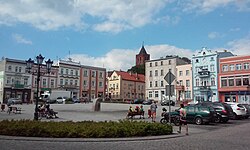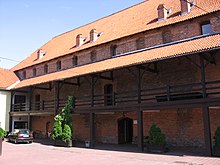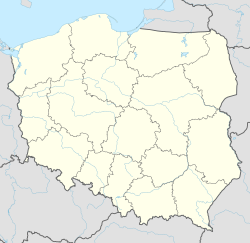Nowe
Nowe | |
|---|---|
 Marketplace | |
| Coordinates: 53°38′58″N 18°43′32″E / 53.64944°N 18.72556°E | |
| Country | |
| Voivodeship | Kuyavian-Pomeranian |
| County | Świecie |
| Gmina | Nowe |
| Area | |
• Total | 3.57 km2 (1.38 sq mi) |
| Population (2006) | |
• Total | 6,252 |
| • Density | 1,800/km2 (4,500/sq mi) |
| Time zone | UTC+1 (CET) |
| • Summer (DST) | UTC+2 (CEST) |
| Postal code | 86-170 |
| Vehicle registration | CSW |
| National roads | |
| Voivodeship roads | |
Nowe [ˈnɔvɛ] (German: Neuenburg in Westpreußen, 1942-1945: Neuenburg (Weichsel)) is a town in Świecie County, Kuyavian-Pomeranian Voivodeship, Poland, with 6,270 inhabitants (2004). It is located within the ethnocultural region of Kociewie.
Geographical location
[edit]Nowe is located approximately 75 kilometers north-east of Bydgoszcz and 80 kilometers south of Gdańsk in an elevated position on the river Vistula. It is located in the historic region of Gdańsk Pomerania.
History
[edit]

The medieval name of the town was Novo Castro, or Nowy Gród in Polish. The town was founded in 1185 by Sobieslaw I, Duke of Pomerania.[1] In 1266 the settlement is mentioned as a fortess place.[citation needed] In 1282 the Franciscan friars settled down here.[citation needed] It was part of the medieval Kingdom of Poland. In 1301 King Wenceslaus II of Poland granted the town to Piotr Swienca.[2]
In 1308 the town was invaded, destroyed and later annexed by the Teutonic Knights.[3] In 1350 it was granted new privileges, later confirmed by King Sigismund I the Old in 1528.[4] Poles recaptured the town after the Battle of Grunwald in 1410, however, after the 1411 peace treaty it fell back to the Teutonic Knights.[4]
In 1440 the town joined the Prussian Confederation, which opposed Teutonic rule,[5] and upon the request of which King Casimir IV Jagiellon re-incorporated the territory to the Kingdom of Poland in 1454. During the subsequent Thirteen Years' War it was captured by the Teutonic Knights in 1458, besieged by Poles in August 1464, and the Teutonic Knights capitulated in February 1465,[6] losing their last stronghold on the west bank of the Vistula. It was reintegrated with Poland, the castle became the seat of the local starosts[6] and the next year the Teutonic Knights renounced any claims to the town. In 1626 and 1655 Nowe was besieged by Sweden.[7]
In 1772, after the First Partition of Poland, the town, as Neuenburg, was annexed by the Kingdom of Prussia and was subject to Germanisation policies, however, in the late 19th century it was still mainly populated by Poles.[8] In 1906–1907, local Polish children joined the children school strikes against Germanisation that spread throughout the Prussian Partition of Poland.[9] From 1871 it formed part of Germany, within which it belonged to Kreis Schwetz in the administrative region of Regierungsbezirk Marienwerder in the Prussian Province of West Prussia. According to the German census of 1910, Neuenburg had a population of 5,152, of which 2,702 (52.45%) were German-speaking, 2,316 (44.95%) were Polish-speaking and 134 (2.6%) were bilingual.[10] In 1920, after World War I, the town became part of the re-established Second Polish Republic as a result of the Treaty of Versailles and was part of the Pomeranian Voivodeship.

After the German invasion of Poland, which started World War II in September 1939, it was occupied and annexed by Nazi Germany, into its newly formed province of Reichsgau Danzig-West Prussia. The Poles were subjected to mass arrests and executions as part of the Intelligenzaktion Pommern.[11] The Germans established a prison in the local courthouse, in which around 200 Poles were imprisoned and tortured in September and October 1939, before being murdered in large massacres in the nearby village of Grupa.[11] Towards the end of World War II, Nowe was captured by the Red Army and after the end of the war, it was restored to Poland.
Number of inhabitants by year
[edit]| Year | Number |
|---|---|
| 1773 | 1,079 |
| 1780 | 1,330 |
| 1831 | 2,430 |
| 1856 | 3,375 |
| 1868 | 4,586 |
| 1875 | 4,712 |
| 1880 | 4,947 |
| 1890 | 4,803 |
| 1905 | 5,142 |
| 1921 | approx. 4,000 |
| 1943 | 5,233 |
| 2006 | 6,252 |
Note that the above table is based on primary, possibly biased or inaccurate, sources.[1][8][12][13][14]
Sights
[edit]
The landmarks of Nowe are the Old Town with the Rynek (market square) filled with colourful historic townhouses, the Gothic churches of Saint Matthew and Saint Maximilian Kolbe, and the medieval Nowe Castle, which today houses the Culture Centre.
Transport
[edit]Nowe is located at the intersection of National road 91 and Voivodeship road 377, and the A1 motorway passes nearby, west of the town.
Sports
[edit]The local football club is Wisła Nowe. It competes in the lower leagues.
References
[edit]- ^ a b Johann Friedrich Goldbeck: Volständige Topographie des Königreichs Preußen. Part II: Topographie von West-Preußen. Marienwerder 1789, p. 65, paragraph 3.
- ^ Słownik geograficzny Królestwa Polskiego i innych krajów słowiańskich, Tom VII (in Polish). Warszawa. 1886. p. 215.
{{cite book}}: CS1 maint: location missing publisher (link) - ^ Słownik geograficzny Królestwa Polskiego i innych krajów słowiańskich, Tom VII, p. 215-216
- ^ a b Słownik geograficzny Królestwa Polskiego i innych krajów słowiańskich, Tom VII, p. 216
- ^ Górski, Karol (1949). Związek Pruski i poddanie się Prus Polsce: zbiór tekstów źródłowych (in Polish). Poznań: Instytut Zachodni. p. XXXVII.
- ^ a b Słownik geograficzny Królestwa Polskiego i innych krajów słowiańskich, Tom VII, p. 217
- ^ Słownik geograficzny Królestwa Polskiego i innych krajów słowiańskich, Tom VII, p. 218
- ^ a b Słownik geograficzny Królestwa Polskiego i innych krajów słowiańskich, Tom VII, p. 214
- ^ Korda, Krzysztof (2019). "Strajk szkolny na Kociewiu 1906–1907". Kociewski Magazyn Regionalny (in Polish). Vol. 2, no. 105. p. 5.
- ^ Landesamt, Prussia (Kingdom) Statistisches (1912). Gemeindelexikon für die regierungsbezirke Allenstein, Danzig, Marienwerder, Posen, Bromberg und Oppeln: Auf grund der ergebnisse der volkszählung vom. 1. Dezember 1910 und anderer amtlicher quellen bearbeitet vom Königlich Preussischen Statistischen Landesamte (in German). verlag des Königlichen Statistischen Landesamts.
- ^ a b Wardzyńska, Maria (2009). Był rok 1939. Operacja niemieckiej policji bezpieczeństwa w Polsce. Intelligenzaktion (in Polish). Warszawa: IPN. p. 167.
- ^ Der Große Brockhaus. Vol. 13 (15th ed.). Leipzig. 1932. p. 295.
{{cite book}}: CS1 maint: location missing publisher (link) - ^ Michael Rademacher: Deutsche Verwaltungsgeschichte Provinz Westpreußen, Kreis Schwetz (2006).
- ^ August Eduard Preuß: Preußische Landes- und Volkskunde, Königsberg 1835, pp. 386–387.






